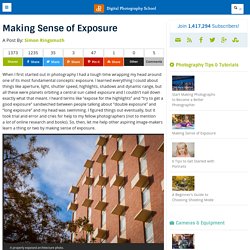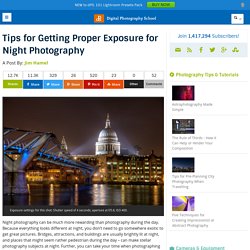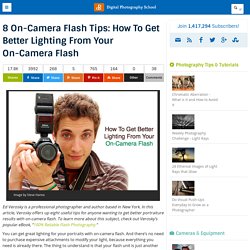

Règle des f:16. La règle des f/16 est un moyen mnémotechnique pour évaluer APPROXIMATIVEMENT les paramètres de prise de vue lorsque l'appareil ne dispose pas de mesure de la lumièreIl s'agit des anciens appareils photos de plus de 30 ans en général ou plus récents si la mesure est défectueuse.Au lieu de ranger votre appareil au placard ou encore d'investir dans un posemètre à main, vous pouvez continuer de l'utiliser en suivant cette règle simple.

Déterminer l'exposition requise (temps et ouverture) La règle de f/16:En plein soleil (de 8h à 17h en été,10h à 14h en hiver) avec une ouverture de f16 utiliser la valeur ISO du film comme vitesse. Par exemple:Film de 200 iso , le soleil est au rendez-vous, j'utilise un des couples suivants: L'hyperfocale. Quand utiliser le RAW et le JPEG ?
How To Improve Your Long Exposure With Photo Stacking. Recently long exposure photography has been quite popular, mainly in the landscape photography arena.

One of the reasons (among the others) is that through a long exposure it is possible to visualize a scene with much more softness and harmony in respect to a standard exposure. Thanks to the rapid evolution of digital cameras, we are now able to take really long exposures without getting so much digital noise, due to sensor overheating. Moreover, the improvements in neutral density filter quality allow us to take pictures with almost no color cast, and no decrease in sharpness. Making Sense of Exposure.
When I first started out in photography I had a tough time wrapping my head around one of its most fundamental concepts: exposure.

I learned everything I could about things like aperture, light, shutter speed, highlights, shadows and dynamic range, but all these were planets orbiting a central sun called exposure and I couldn’t nail down exactly what that meant. I heard terms like “expose for the highlights” and “try to get a good exposure” sandwiched between people talking about “double exposure” and “long exposure” and my head was swimming. I figured things out eventually, but it took trial and error and cries for help to my fellow photographers (not to mention a lot of online research and books). So, then, let me help other aspiring image-makers learn a thing or two by making sense of exposure. A properly exposed architecture photo. Here’s the most basic, but informative, definition I can offer of exposure: it’s how bright or dark your photograph is. Sounds simple, right? Choosing Lenses: When to Use Which Lens and Why. All DSLR systems offer a dizzying selection of lenses for their cameras.

These range from fisheyes that give a 180° field of view, to telephoto lenses up to 800mm or more. You’ve got zooms, primes, macro, super telephoto, and of course, tilt-shift lenses as well. In my time as a photographer I’ve often had friends, students, or casual acquaintances ask me “What lens should I get?” There is no one right answer to this question, and it can lead to more confusion unless I ask a few questions myself. First off, and easiest to figure out is, “What do you want to shoot?”
After those two questions are answered it becomes more difficult. Tips for Getting Proper Exposure for Night Photography. Exposure settings for this shot: Shutter speed of 4 seconds; aperture at f/5.6; ISO 400.

Night photography can be much more rewarding than photography during the day. Because everything looks different at night, you don’t need to go somewhere exotic to get great pictures. Bridges, attractions, and buildings are usually brightly lit at night, and places that might seem rather pedestrian during the day – can make stellar photography subjects at night. Further, you can take your time when photographing at night, more so than during the day. There are generally less people out, and you don’t have to worry about the light changing. Unique Flower Photography Using Multiple Exposures. Most of the new cameras from both Nikon and Canon now have the capability to create multiple exposures.

The technique is rather simple to set up, but the results can be both unlimited and unpredictable. So try using this feature to create some unique floral images. Set-up Select Multiple Exposure from your camera’s menu. The default option on this setting is, of course, OFF. Taking multiple exposure images does take some practice to perfect, and you will have a lot of throwaways. Slow Sync Flash. One camera function that can be a lot of fun to play with (and that can get you some interesting results) is slow sync flash.

Low Light Photography Options When shooting with a subject in low light situations you generally have two options; either to shoot with a flash or to shoot with a slow shutter speed. 1. Flash – When shooting in low light with a flash in auto mode your camera will choose a relatively fast shutter speed. This means that your subject will be well lit and that if it is moving it will be frozen and as a result will be sharp. 2. Both of the above options are legitimate technique but both have their weaknesses. What is Slow Sync Flash? 8 On-Camera Flash Tips: How To Get Better Lighting From Your On-Camera Flash - Digital Photography School. Image by Steve Hanna Ed Verosky is a professional photographer and author based in New York.

How to Approach Strangers on the Street and Ask for Their Picture. Street portraiture is absolutely, unequivocally, why-would-anybody-do-this-for-a-living terrifying… in my opinion.

The thought of approaching a complete stranger on the streets of New York City and asking if they would let me take their photo seems about as appealing to me as asking a mamma bear if she would mind me riding her 2 week old cub for a few miles. That said, I also want to learn. I want to be able to go up to the man sitting on the stoop with a far-off look in his eye and ask him for his picture and… just maybe… his story. This is what Humans of New York creator, photographer, and #1 New York Times bestselling author Brandon Stanton does better than anybody else in the world. 100 Things I’ve Learned About Photography. 3 Reasons to Control your Flash and 10 ways to do It. One-Shot vs. AI-Servo: When To Use Each. First off, this article would be called AF-S vs.

AF-C if I were a Nikonian, they are the same thing so everyone gets to play! Don’t you wish they all just called everything the same thing? This is my second article to coincide with the sale of my ebook over at Snapndeals, DPS’s new sister site for awesome deals on photography stuff. If you haven’t checked out my ebook “Tack Sharp” yet, please do so! 10 Photography Hacks that will Dramatically Improve Your Photos. Mike is the author of the eBook Hacking Photography: A Plain-English Guide to Taking Impressive Photos – Fast. Click here to view more details There is a widely accepted rule called The Pareto Principle also known as the 80:20 rule. In short, it states that 80% of the results come from 20% of the efforts. I find that in learning photography, this can even skew much higher. This means that potentially improving 5% of your photographic knowledge in the right places, could improve your photography by 95%!
Tutorial: An Easy Way to Make Beautiful Powder Clouds. Dina Belenko is a creative still-life photographer from Russia and incredibly successful 500px Prime photographer. Her artistic images capture magical stories behind everyday inanimate objects. In this tutorial, Dina shows you how she shot her photo “kitchen mess” and discovered a really great way to capture beautiful powder clouds (no, she didn’t just throw the powder…).
4 Tips to Help you Decide Between Black and White or Color for your Image. Why do black and white photographs speak to us? In nature, colors are meant to attract, and cause things to catch our attention. Still, even without color, black and white images are a mainstay of our craft, and are powerful representations of the artistic spirit. There are many differing opinions when it comes to black and white photography. Some photographers love it, and shoot black and white exclusively, while other photographers absolutely shun the notion and shoot only in color. Then you have the majority of our lot who fall somewhere in between the love and hate poles. Here are four tips to help you decide if an image will be more appealing in black and white than in color.
Black and white or color? 10 Silly Mistakes That Can Ruin Your Image Quality. Central Park South. How many times have you captured an amazing image only to view it on your computer, or as a print, and realize that you screwed something up along the way. Unfortunately, the only way to stop doing a lot of these easy-to-make mistakes is to have an image ruined by them. Once you screw up an image you’ll quickly learn not to make the same mistake again. Here are the most frequent ways I see photographers ruining their images.
Avoid these 10 mistakes that can ruin your images 1. Everyone learns this tip too late. Five Photoshop Tools to Take Your Images from Good to Great. Seascape image – Before and After image editing We hear it all the time, “That photo has been Photoshopped”. Wat is spotmeting? 10 Quotes Every Photographer Should Know. How to Take Better Action Photos. There are many sports photographers. We generally hear about those who specialize in a specific genre of sports photography like motorsport, tennis, golf, or surfing. Trucs et Astuces. Archive of ‘Trucs et Astuces’ category Dans le cadre de la randonnée photo, activité que j’anime tous les samedis dans la belle région des Cantons-de-l’Est, au Québec, je suis toujours à l’affût de nouvelles idées pour aider les participants à développer leur habilité photographique.
Maîtriser son Art. Netteté. Il existe de nombreux paramètres qui influent sur la netteté finale d’une image numérique. Respecter l’ensemble des recommandations qui suivent ne peut qu’améliorer significativement vos résultats sur ce point. Compareriez vous la netteté des images fournies par deux appareils , l'un tiré en 30/45cm et l'autre en 50/70cm? AF-C, AF-S, AF-A, 9 points, 21 points, suivi 3D ... : quel mode autofocus et mode zone AF choisir. Le choix du mode autofocus est un des sujets qui revient le plus souvent parmi les questions de nos lecteurs. La photographie au flash. Conseils photo + 50 idees pour developper sa creativite - Crazy Pixel : Photographe ille et vilaine Bretagne. Ne vous mettez pas la pression. 5 astuces pour réussir vos photos de fleurs. Avec l’arrivée du printemps, la nature se réveille progressivement de son long sommeil hivernal. Les arbres se mettent à bourgeonner, les premières fleurs commencent à éclore, les oiseaux chantent… Et si vous profitiez des beaux jours pour sortir votre appareil et prendre des photos de fleurs ?
7 astuces pour prendre plus que des photos de vacances. 15 conseils pour réussir vos photos. Comment progresser en photo avec un exercice tout simple ? Les styles d’image, c’est quoi ? MP #87 : Qu’est-ce que les Exifs ? A quoi cela sert. #6 - L'expérience. #1 - La créativité. Plan du site Surlimage. Packshot (fond blanc) sans matériel spécifique.
Déclenchez-moi - RendezVousCreation - Nicolas Esposito. L’art de prendre la photo juste au bon moment : the perfectly timed photos. 33 Pictures Taken At The Right Moment. L’art de prendre la photo juste au bon moment : the perfectly timed photos. Le MOMENT ( photos de Paris ) 3 filtres pour sublimer vos photos de paysage. Comment progresser en photo avec un exercice tout simple ? Photographie de paysage - 2 erreurs à ne pas commettre.